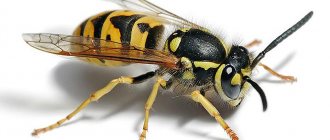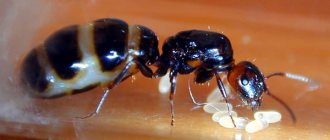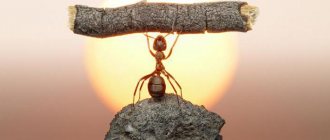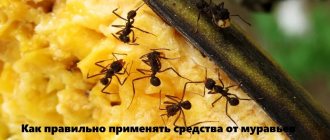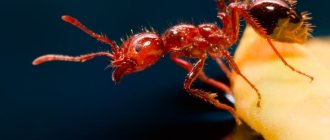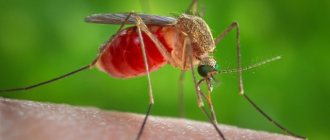Description
Wood ants have a large body, the length of which reaches 1.5 cm. The head is disproportionately large compared to the small chest. Long antennae necessary for touch are localized on it. The males of these insects are visually very different from the females.
Male wood ants have a darker body and red or yellow legs . In addition, they have wings. Female forest representatives have a smaller body of a red-brown color.
They only have wings during the mating season, and then they chew them off. Working individuals are also red-brown and without wings.
Ant larvae have an elongated, large, white body, covered with hairs. During molting, they turn into pupae. To leave the pupa, insects are helped by workers. They break the cocoon, and the young wood ant becomes a full-fledged member of the community.
Harm from working insects
Many gardeners know the damage aphids cause to trees, but they are bred by ants. However, on a forest scale the damage is less than the benefit.
People should be wary of these insect bites. The acid can cause swelling, itching, and sometimes pain and dizziness. Allergy sufferers can even experience anaphylactic shock. Previously, there was such torture: criminals were stripped, tied up and left on an anthill. Formic acid is also dangerous for the eyes.
To assess whether the red forest dweller brings benefit or harm, we must proceed from each specific case. For example, having settled in a hay meadow, they will interfere. In the forest, aphids, which are protected by ants, do not cause as much damage as in private farms. Fruit pests are not food for ants, but they can seriously damage pears, apples and plums.
Peculiarities
The red forest ant has the following features:
- The insect's abdomen has a gland filled with a toxic substance. Forest dwellers use it to protect themselves from enemies. The poison is very painful. Even people feel discomfort from it. And with multiple bites, an allergic reaction can be provoked.
- Wood ants are completely deprived of the organ of hearing, so they do not hear anything. In contrast to this, they have a well-developed sense of smell. Thanks to him, these forest inhabitants can freely navigate the terrain and find prey.
- The organ of vision in forest ants does not work at full capacity. They see, but only violet shades.
- The insect has powerful jaws. Their mouthparts perform several tasks at once: construction, defense, and grasping prey. And also with their help, insects carry eggs and larvae.
Working individuals of red forest ants live 5-6 years, and queens live up to 20 years.
Varieties
Red forest ants have the following classification:
- Small or forest bareback. Its body length is 7-14 mm, color is red-brown. Found in the temperate zone of northern Eurasia. They create large anthills from needles and twigs (up to 2 m in height).
- Northern forest. Found in temperate forests of Eurasia. Listed on the red list of threatened species.
- Hairy forest. The length of working ants is 4-9 mm, and females and males reach 9-11 mm. They are also listed in the Red Book.
In addition, there are blood ants and black-brown wood ants.
Biochemistry
The following pheromone substances have been found in various glands:
- formic acid (CH2O2), alarm pheromone[10] and protective substance[11];
- decan (C10H22), alarm pheromone[10];
- undecane (C11H24), alarm pheromone[10] and protective substance[11].
The venom of red wood ants is approximately 50% formic acid (CH2O2) (Stumper, 1951). The following substances were found in the Dufour glands: n-Nonan, n-Decane, n-Undecane, 9-Undecene, n-Dodecane, 1-Dodecene, 3-methylundecane, 5-methylundecane, n-Tridecane, n-Tetradecane, 3- methyltridecane, 5-methyltridecane, Tetradecene, n-Pentadecane, 7-Pentadecene, n-Hexadecane, n-Heptadecane, cis-8-Heptadecene, Heptadecadiene, n-Octadecane, 9-Octadecene, n-Nonadecane, 9-Nonadecene, Nonadecadiene, n-Eicosane, Eikosene, n-Geneicosane, Gneicosene, n-Docosane, Tricosene, acetates (tetradecyl, hexadecyl, hexadecenyl, octadecyl, geranylgeranyl) and others [12][13][14].
We suggest you read: How to deal with ants on your property
Lifestyle
The small forest ant is often found in deciduous, coniferous or mixed forests that have existed for 20-30 years. In the summer, insects are very active, and in the winter they hibernate underground. Forest representatives, like all other species of these insects, are very hardworking.
Forest ants create colonies that live in anthills-nests. They build them in the ground, wood or under stones. Forest insects are well organized. All members of the family have clearly assigned responsibilities.
Forest ants are divided into several castes:
- Females (queens or queens). Representatives of the female species lay eggs. From them, male representatives of the family emerge (from eggs that were not fertilized) and female individuals (from eggs that were fertilized). The body of the queen is noticeably larger than that of males and worker ants. The only long-lived person in the colony is the queen.
- Males. The task of male ants is to participate in mating. After a while, they are destroyed by other relatives from the anthill. Males are smaller than females. They have wings, but they only live 2-3 weeks.
- Foragers (working individuals). These are female representatives whose reproductive system is underdeveloped. They build an anthill and care for their offspring. Their size is significantly smaller than the uterus. They don't have wings.
- Soldier ants. These working members of the family have a large head and highly developed jaws. They duplicate the duties of worker ants and also protect their nest from enemy invasions.
The female mates only once in her life. The resulting male material is enough for her to produce offspring throughout her life (10-20 years).
Benefits of forest ants
Ants secrete a substance known as formic alcohol. It is used in medicine to treat a number of diseases, including simply for disinfection.
Ant passages are very beneficial for the soil; oxygen penetrates into the ground through them. Ants are protectors of the forest; they eat many pests and themselves become food for birds.
The insect colony prevents the excessive proliferation of harmful insects. When a species begins to multiply intensively, the ants completely switch to it: there it is even easier for them to obtain food for their numerous larvae.
In nature, there are no only harmful or only beneficial insects. There are situations in which one or another species can either be useful for a person, or cause him a lot of problems.
And only for summer residents, red ants are a real disaster: the diet of these individuals is mostly honeydew (sweet secretions of aphids). Ants protect aphids, breed them in huge quantities and even take them with them to the anthill for the winter. Aphids cause enormous damage to gardens and vegetable gardens, destroying all vegetation.
Therefore, the appearance of these forest guests in summer cottages causes real panic. Black garden ant. This insect undoubtedly does more harm than good. When settling in gardens, they happily eat the fruits of fruit trees and suck nectar from flowers, damaging them. And just like red ants, they breed herds of aphids.
The harvester ant is of considerable benefit in the virgin steppes, where it actively spreads plant seeds. But if these insects live near the currents where grain is threshed, this threatens a serious disaster for the harvest.
The carpenter ant is useful because it destroys pests, insect corpses, as well as larvae living under the bark of trees. But woe is it if woodworms have chosen for their settlement prepared boards stacked in a barn or in the courtyard of a residential building. By grinding down the wood from the inside and turning it into dust, they make the building material completely unsuitable for use.
Ants bring a lot of trouble to humans only when they settle in close proximity to him. Nature would hardly live and flourish without these little hard workers. You need to remember this when you want to stir up and destroy an anthill just for fun.
Nutrition
The small forest ant eats absolutely everything. Any insects and their larvae are the basis of the diet of forest ants. Therefore, all trees that grow next to the anthill are reliably protected from pests. In addition, ants love plant sap, as well as the sugary secretions of aphids.
The food suppliers in the anthill are the older workers . More aggressive members of the family engage in hunting. When attacking a victim, the ant paralyzes it with a special acid.
Then he drags the immobilized victim into the anthill. There it is divided into pieces and distributed among adult relatives and individuals.
A hungry relative can get food by tapping his antennae on the forager's head. He will immediately give him a small portion of food. Having satisfied his hunger, he takes the rest of the food deep into the nest, where he feeds other ants, as well as their larvae.
If the forager breaks the rules and does not bring food to the anthill or does not want to share, then they do not stand on ceremony with him for a long time and eat them.
Among the workers there are nannies who care for eggs, larvae and nymphs. They deserve a good portion of food. They spend a lot of effort dragging their offspring from chamber to chamber in order to provide them with suitable development conditions according to age characteristics. Wood ants also collect the sweetish secretions of aphids. In one season they manage to prepare up to 20 kg of such food.
Reproduction
New male and female individuals from the eggs laid by the uterus are born in the spring. On a warm day after rain, females and males with wings leave the nest.
Having flown 30-40 meters from the anthill, they land and begin mating. After this, the female bites off her wings, forms a new colony or returns to her previous home.
After intercourse, all male ants die. The new queen lays 10 eggs every day . And the workers take care of the offspring. Nymphs produce a special liquid that forms thin webs when exposed to air. Cocoons are spun from them. After 1.5 months, a young forest ant appears.
Young insects have a soft body, a light red chest, and a gray head and chest. After 2-3 days, the chitinous cover gradually hardens, and the ant acquires the color of an adult. At this stage, the teenager loses the guardianship of his older relatives and begins to work on an equal basis with everyone else.
The queen controls her colony, and the ants recognize each other thanks to special pheromones. When forest ants from different colonies meet, it is difficult to avoid a fight.
Aliens bite each other and spray formic acid. They also attract their relatives to help. There are even massive battles that last 2-3 days in a row.
Meaning
Ants secrete such a useful substance as formic alcohol. It is used in modern medicine to treat rheumatism, rheumatoid arthritis, tuberculosis, hepatitis, bronchial asthma, kidney failure, and diabetes. Helps with hair loss.
Forest ants have a very broad positive effect on the soil - they loosen it, enrich the soil with oxygen and nutrients, and increase the biological activity of the soil.
They are the main food for many useful forest and commercial birds, such as woodpeckers, tits, black grouse, and wood grouse.
They increase the grass cover in the forest and enrich it.
They regulate the number of harmful insects by eating any species that has begun mass reproduction. They often switch completely to this type, suppressing further spread.
However, in the forest this feature causes much less harm than in gardens and vegetable gardens.
Red forest ants play an important role in regulating the number of widespread forest pests, primarily needle-eating caterpillars of butterflies and false caterpillars of sawflies. Ants improve the soil and disperse seeds of forest plants. One large anthill saves a quarter of a hectare of forested area from pests[3].
Several special methods have been developed for the artificial resettlement of red forest ants to new forest areas: 1) early spring relocation (the first Goesswald method); 2) relocation with pupae; 3) relocation with additional replanting of females (second Gösswald method)[3]. When using Hesswald's second method, winged females and males are collected during the mating flight.
This technique was first developed by the German myrmecologist Karl Gößwald (1907–1996) in 1939 and was widely used in the GDR, Italy and the Federal Republic of Germany. Winged females and males are collected using a special cap made of gauze, stretched over a wooden or metal frame and a funnel fixed in the upper part of the cap, on the narrow part of which there is a rubber tube connecting the funnel to a large jar.
Winged females and males climb up the wall of the cap, fall into the funnel and from there into a jar with a small amount of nesting material without ants. Then the winged individuals are placed in a special cage for mating. After fertilization, the males die, and the females can be placed in artificial layers. However, in gardens and beech forests, ants can cause harm by breeding aphids[3].
In medicine, red forest ants are used as a medicine of animal origin. Contain formic acid, which acts as a poison and pheromone; alkane undecane, which performs a signaling function; essential and fatty oil; protein substances; chitin, minerals, mainly calcium phosphate. Formic acid was first isolated in 1671 by the English naturalist John Ray from this species of ant.[18]
Dry and live ants are used to prepare medicines - formic alcohol and tinctures for the treatment of joints and neuralgia as a distraction. Used in homeopathy[19].
